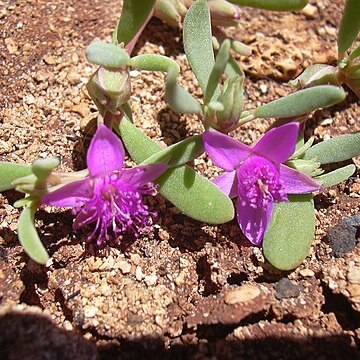Prostrate, creeping, ascending or erect succulent herbs or undershrubs. Leaves opposite, exstipulate, often by their sheathing bases connected in pairs, linear, lanceolate or oblong, very fleshy. Flowers axillary (only spuriously so?), solitary, clustered or cymose, sessile or stalked, bibracteolate, actinomorphic, ☿. Perianth gamophyllous, deeply 5-partite; tube obconical; segments oblong, obtuse, just below the apex often dorsally apiculate, coloured inside. Stamens either 5, alter-nating with the perianth-segments, or ∞, inserted in the mouth of the perianth-tube; filaments filiform or very narrowly linear, free or connate at the base; anthers 2-celled. Ovary superior, 3-5-celled; cells ∞-ovuled. Styles 3-5, filiform, stigmatose on the inner side. Capsule oblong, thin-walled, 3-5-celled, operculate. Seeds several in each cell, globose-reniform; testa smooth; embryo annular.
Succulent, erect or prostrate, annual or perennial herbs; branches rarely rooting. Leaves fleshy, often more or less terete; exstipulate; petioles sheathing, often connate at base. Inflorescences axillary, of one or more sessile or pedicellate flowers, minutely 2-bracteate at base of pedicel. Flowers perigynous; sessile or pedicellate; perianth-segments 5, imbricate, inside coloured, outside green, appendage dorsal, near apex, long-apiculate; petals absent; stamens either 5, free, or numerous and inserted on perianth-tube, filaments filiform, glabrous; ovary 2-5-locular, ovules numerous, placentation axile, styles (2-)3-5. Fruit a membranous, circumscissile capsule, (2-)3-5-locular, operculum conical, septa incomplete in ripe fruits; seeds numerous in each locule, cochleate to reniform, completely covered by a thin aril, smooth or rough to papillose.
Herbaceous or suffruticose plants, upright or prostrate, sparsely branched. Leaves simple, opposite, more or less equal, fleshy, generally linear, elliptic or narrowly obovate, the petioles clasping or connate and surrounding the stem; estipulate. Inflorescence axillary or rarely terminal, glomerules or the flowers solitary. Flowers bisexual, sessile or pedicellate. Perianth 5-parted, connate below, the lobes generally appendaged on the outer surface beneath the apex, imbricate. Stamens 5, free and alternitepalous, or numerous, and inserted on the perianth tube. Ovary superior, 3-to 5-loculate, the ovules campylotropous, many on the axile placenta, the styles 3 to 5. Capsule circumscissile; seeds numerous, reniform, the testa smooth, estrophiolate.
Erect, decumbent or creeping succulent annual or perennial herbs or sub-shrubs. Leaves opposite, subopposite, or alternate, sessile or petiolate, linear, lanceolate, oblong, elliptic or ovate, entire, succulent. Stipules absent. Flowers axillary, solitary, sessile or pedunculate, bibracteolate, hermaphrodite, regular. Calyx gamosepalous, 5-partite; calyx-lobes triangular, dorsally apiculate, green outside, coloured inside; calyx-tube short, obconical. Stamens 5-many, free or connate at the base, inserted in the mouth of the calyx-tube. Carpels 2–5, superior, united; ovary 2–5-locular; styles 2–5; ovules many; placentation axile. Fruit a circumscissile capsule, the lid remaining whole. Seeds several to many, black.
Herbs or shrubs, most parts with white bladder cells. Stems ascending, rarely creeping. Leaves opposite; petiole broadening basally forming a papery sheath clasping stem; leaf blade cylindric to obovate, fleshy. Inflorescences cymose or flowers solitary. Flowers bisexual, sessile or pedicellate. Perigone 5-parted, lobes inside often pink to purple, rarely white, oblong, ending in protracted spurs. Stamens 5 to numerous, free or inserted in perigone tube. Perigynous, ovary free from perigone tube, 3-5-loculed, ovules numerous per locule; stigmas 3-5, linear. Capsule ellipsoid, thinly walled, membranous, circumscissile. Seeds many per locule, enveloped by a black smooth aril.
Succulent, glabrous perennial herbs; stems rooting at nodes. Leaves opposite, fleshy, connate at base. Flowers solitary, axillary, pedicellate; bracts absent. Perianth segments 5, triangular with scarious margins, a dorsal mucro behind apex. Stamens 5 to numerous; staminodes absent. Ovary superior; styles and locules 2–5; ovules several per locule; placentation axile. Fruit a circumsciss capsule, the upper part (operculum) ovoid, smooth. Seeds several, pea-shaped to comma-shaped, smooth, black.
Fls perfect, perigynous; sep 5, spreading at anthesis, persistent, each usually with a dorsal appendage near the tip; pet none; stamens 5–many; ovary 3–5-locular, with 3–5 styles and many ovules; capsule circumscissile; seeds arillate; succulent, fibrous-rooted herbs with opposite, exstipulate lvs, the small fls solitary or few in the axils, sessile or nearly so. 8, warm reg.
Fruit a conical circumscissile capsule, the lid pointed, remaining whole, thin-walled, the lower part thickened below the line of dehiscence or all over.
Perianth 5-partite; lobes triangular, spreading, dorsally apiculate behind the tip, green outside, pink or purple inside; tube short, obconical.
Leaves alternate, opposite or subopposite, usually petiolate and unequal, lanceolate, oblong or elliptic, entire, succulent, without stipules.
Carpels 2–3, superior, united; ovary 2–3-locular; styles 2–3; ovules ?; placentation axile.
Flowers axillary, solitary, regular, hermaphrodite, sessile or pedunculate, 2-bracteolate.
Seeds several-?, black, rounded, with a prominent hilum, smooth or rugose.
Prostrate or semi-prostrate succulent annual or perennial herbs.
Stamens 5–?, free, inserted at the mouth of the perianth-tube.

